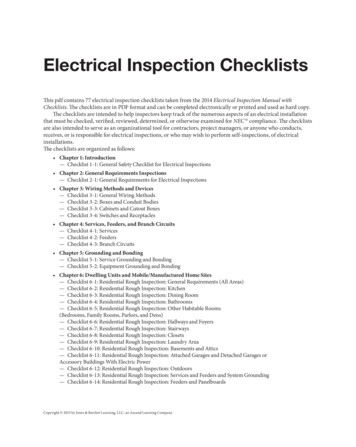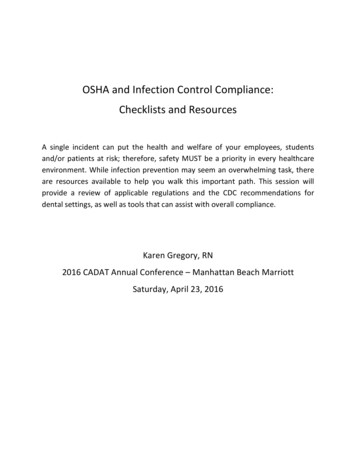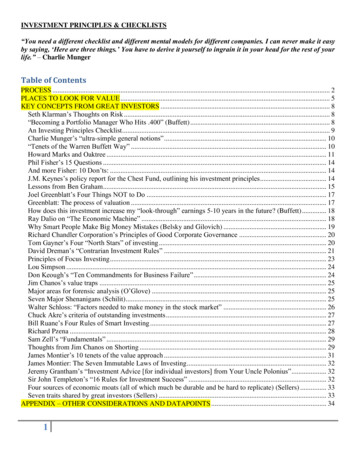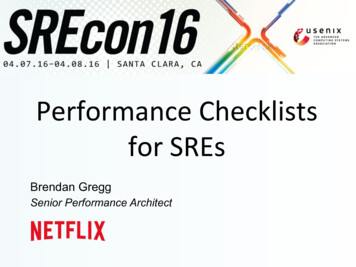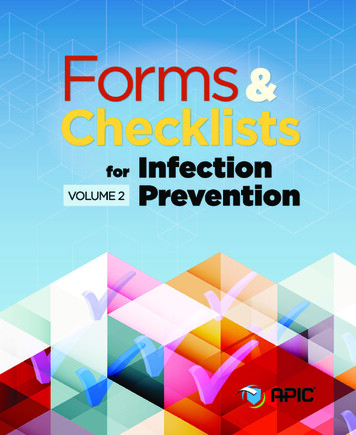
Transcription
Forms & Checklists for InfectionPrevention, Volume 2About APICAPIC’s mission is to create a safer world through prevention of infection. Theassociation’s more than 15,000 members direct infection prevention programsthat save lives and improve the bottom line for hospitals and other healthcarefacilities. APIC advances its mission through patient safety, implementationscience, competencies and certification, advocacy, and data standardization.
Forms & Checklists for Infection Prevention, Volume 2 2017, Association for Professionals in Infection Control and Epidemiology, Inc. (APIC)All rights reserved. Use of this APIC publication does not grant any right of ownership or license to any user.Printed in the United States of AmericaFirst edition, October 2017ISBN: 978-1-933013-70-1All inquiries about this publication or other APIC products and services may be addressed to:APIC1400 Crystal Drive, Suite 900Arlington, VA 22202Telephone: 202-789-1890Fax: 202-789-1899Email: info@apic.orgWeb: www.apic.orgDisclaimerThe Association for Professionals in Infection Control and Epidemiology, its affiliates, directors, officers, and/or agents(collectively, “APIC”) provides this book solely for the purpose of providing information to APIC members and the general public.The material presented in this book has been prepared in good faith with the goal of providing accurate and authoritativeinformation regarding the subject matter covered. However, APIC makes no representation or warranty of any kind regarding anyinformation, apparatus, product, or process discussed in this book and any linked or referenced materials contained therein, andAPIC assumes no liability therefore.WITHOUT LIMITING THE GENERALITY OF THE FOREGOING, THE INFORMATION AND MATERIALS PROVIDEDIN THIS BOOK ARE PROVIDED ON AN “AS-IS” BASIS AND MAY INCLUDE ERRORS, OMISSIONS, OR OTHER INACCURACIES. THE USER ASSUMES THE SOLE RISK OF MAKING USE AND/OR RELYING ON THE INFORMATIONAND MATERIALS PROVIDED IN THIS BOOK. APIC MAKES NO REPRESENTATIONS OR WARRANTIES ABOUTTHE SUITABILITY, COMPLETENESS, TIMELINESS, RELIABILITY, LEGALITY, UTILITY OR ACCURACY OF THEINFORMATION AND MATERIALS PROVIDED IN THIS BOOK OR ANY PRODUCTS, SERVICES, AND TECHNIQUESDESCRIBED IN THIS BOOK. ALL SUCH INFORMATION AND MATERIALS ARE PROVIDED WITHOUT WARRANTYOF ANY KIND, INCLUDING, WITHOUT LIMITATION, ALL IMPLIED WARRANTIES AND CONDITIONS OF MERCHANTABILITY, FITNESS FOR A PARTICULAR PURPOSE, TITLE, AND NON-INFRINGEMENT.IN NO EVENT SHALL APIC BE LIABLE FOR ANY INDIRECT, PUNITIVE, INCIDENTAL, SPECIAL, OR CONSEQUENTIAL DAMAGES ARISING OUT OF OR IN ANY WAY CONNECTED WITH THE USE OF THIS BOOK OR FOR THEUSE OF ANY PRODUCTS, SERVICES, OR TECHNIQUES DESCRIBED IN THIS BOOK, WHETHER BASED IN CONTRACT, TORT, STRICT LIABILITY, OR OTHERWISE.
AcknowledgmentsDevelopment of this book required input and expertise from a team of editors, who assembledmaterials from a range of facilities and other resources including the public domain. The Association forProfessionals in Infection Control and Epidemiology acknowledges the valuable contributions from thefollowing individuals.Lead EditorProject ManagementSusan Jukins Hudson, RN, BSN,MPH, CIC, LHRMSenior Clinical ConsultantPremier, Inc.Charlotte, NCSusan F. SandlerDirector, Practice ResourcesAssociation for Professionals in Infection Controland EpidemiologyAssociate EditorsGeorge Allen, RN, PhD, FAPIC,CIC, CNORDirector, Infection Prevention and ControlNewYork-Presbyterian Brooklyn MethodistHospitalBrooklyn, NYDebbie Hurst, RN, BSN, CHESP, CICInfection Prevention & Control ConsultantHandsOn IC Consultative Services LLCMedford, ORReviewersTeri Hulett, RN, BSN, CIC, FAPICInfection Prevention ConsultantInfection Prevention Strategies, LLCThornton, COCynthia A. Kohan, MT(ASCP), MS, CICInfection Prevention SpecialistProspect Waterbury HospitalWaterbury, CNJames EbersoleAssistant Editor, Practice ResourcesAssociation for Professionals in Infection Controland EpidemiologyElizabeth GarmanVice President, Communications andPractice ResourcesAssociation for Professionals in Infection Controland EpidemiologyProductionSarah VickersArt Director (cover art)Association for Professionals in Infection Controland EpidemiologyProject Design CompanyText Design and LayoutWashington, DCModern LithoPrintingJefferson City, MOCarol Vance MSN, RN, PHN, CICManager of Infection Prevention andOccupational HealthHSHS St. Elizabeth’s HospitalBelleville, ILDeclarations of Conflicts of InterestOnly individuals who have made declarations of potential conflicts have been listed here.George Allen, RN, PhD, FAPIC, CIC, CNOR is a member of the Association for periOperativeRegistered Nurses AORN Journal Editorial Board.
Table of ContentsSECTION 1 Patient Care Policies1-1Cleaning and Disinfecting PatientCare Equipment .71-2Comparison of Characteristicsof Selected Chemicals .101-3Chlorhexidine (CHG) Bathing.111-4Outbreak Investigation, InfluxInfectious Patients .161-5List of Multidrug-ResistantOrganisms (MDROs).241-6Bed Bug Policy .251-7Clostridium difficile Policy .311-8Legionella Policy .341-9High-level Disinfection Policy .411-10 Scabies Treatment .431-11Tuberculosis Control Plan .441-12 Post-Exposure Prophylaxis to PreventTransmission of HIV .481-13 Section Resources .52SECTION 2 Department Policies2-6Food and Nutrition Services Policy .742-7Environmental Services Policy .802-8Emergency Department Policy .842-9Central Sterile Processing Policy .872-10 Dental Clinic Policy .932-11 Environmental Cleaning inPatient Areas Policy .952-12 Intensified Terminal RoomCleaning EVS Policy .972-13 Bed Bugs Management .992-14 Environmental Managementof Maggots .1012-15 Managing Lice Infestation .1032-16 Section Resources .105SECTION 3 Occupational Health3-1Respiratory Protection Program.1073-2Recommended Vaccines forHealthcare Workers .1103-3Sample Job Hazard Analysis Form .1113-4Disposable Glove Use for PPE .1122-1Pharmacy Policy .553-52-2Pediatrics and Pediatric IntensiveCare Unit (PICU) Policy .58Checklist for Bloodborne PathogensTraining Content .1133-62-3Radiology Policy.62Sharps Needle Disposal Policy .1143-72-4Operating Room Policy .65Sharps Injury Log .1153-82-5Classification of SurgicalSite Infections .71Employee Training Record .1163-9Safety Meeting Record .1173-10 Section Resources .118
SECTION 4 Construction andRenovation4-1Infection Control Risk Assessment .1194-2Construction & Renovation Policy.1284-3Matrix of Precautions forConstruction & Renovation .1324-4 Pre-Project Safety Punch List .1354-5End of Project Safety Punch List .1374-6 Caution During Renovation Sign .1394-7Section Resources .140SECTION 5 Long-Term Care5-1Long-Term Care Facility HandHygiene Observation Tool .1415-2Core Elements of AntibioticStewardship in Nursing HomesChecklist .1435-3Infographic on AntibioticStewardship in Nursing Homes .1455-4LTC Facility EnvironmentalCleaning Checklist .1465-5Inter-facility Infection ControlTransfer Form 1.1485-6Inter-facility Infection ControlTransfer Form 2.1505-7Medical Care Referral Form .1525-8Section Resources .153APPENDIXResources .155Acronyms .158
IntroductionForms & Checklists for Infection Prevention, Volume 2 was designed to provide additional resources forthe infection preventionist (IP) from novice to expert, aiming to complete the scope of responsibilitiesin infection prevention begun in Forms & Checklists for Infection Prevention,Volume 1. The editors haveselected and organized this compilation of forms, checklists, policies, and guidelines to create a convenientresource for IPs. These resources are not intended to be all inclusive—instead, they provide a variety ofsamples to aid IPs in creating, improving, and enhancing their infection prevention and control programs.This second volume of resources is presented in five sections: Patient Care Policies, Department Policies,Occupational Health, Construction and Renovation, and Long-Term Care. Each section providessample forms, policies, guidelines, and links to additional resources and background reading in SectionResources pages. The samples may be modified to meet an individual facility’s needs for their particulardemographic population. Please note that every effort has been made to verify the internet links providedas resources; however, at times the location of information may change.Infection prevention is the discipline responsible for prevention of healthcare-associated infections, datingback to the first half of the 18th century. Each passing century has given birth to new and formidablepathogen adversaries against which infection prevention continues its fight. IPs work against the spread ofdisease through education, prevention, and control of transmission in the healthcare environment.The resources in this book can help IPs to create structured infection prevention programs, develop staff,patient, and visitor awareness, and promote a safe healthcare environment for patients, visitors, and staffmembers. These resources can also raise awareness of expanded infection prevention opportunities withcollaboration between hospitals and long-term care settings to promote our vigilant efforts to prevent,reduce, and protect against both existing and emerging pathogens.It is only through continued teamwork, collaboration, research, and education that we can be successfulstewards. The IPs who shared their time, resources, and expertise hope that you will find this bookuseful, and that it will spark the continued motivation to communicate and share your research,accomplishments, and lessons learned as we face the future of existing and emerging infectious diseasesand the continued challenges to protect our patients through prevention and control.Susan Jukins Hudson, RN, BSN, MPH, CIC, LHRMGeorge Allen, RN, PhD, FAPIC, CIC, CNORDebbie Hurst, RN, BSN, CHESP, CICOctober 2017
SECTION 11Patient CarePolicies
SECTION 1
Forms & Checklists for Infection Prevention, Volume 21-1. C leaning and Disinfecting PatientCare EquipmentPOLICY & PROCEDURE DESCRIPTION: Infection PreventionDATE ISSUED: Jun 2016SUPERSEDES: May 2016DEPARTMENT: Infection PreventionPOLICY NO: 5076-517REVIEWED BY: Infection Control CommitteeDATE REVIEWED: 6/16PurposeTo minimize the risk of transmitting infections, between patients or employees, via contact withequipment that may be contaminated.PolicyNon-critical patient care equipment (touch intact skin) must receive low-level disinfection with ahospital grade disinfectant before use on each patient. Surfaces must be pre-cleaned when visiblysoiled before being disinfected. Low level disinfection is performed following the manufacturer’sinstruction for use (IFU) using either bleach germicidal disposable wipes (4 minute wet time), theSuper Sani-Cloth germicidal disposable wipe (2 minute wet time) or a hospital grade disinfectionproduct such as Q256 (10 minute wet time).ProcedureThe following grid outlines the procedure to be utilized for cleaning some of the most commonly usedpatient care equipment:Shared Equipment All In-patient Care UnitsEquipmentUserTimingProductAutomated Vital SignmachineNursingBefore use on eachpatientSani-clothBP cuffs/machinesNursingBefore use on eachpatientSani-clothGeri chairs/reclinersEVSDaily & discharge roomcleaningSani-clothCommodeEVSDaily & discharge roomcleaningBleach wipesGlucose monitorsNursingBefore use on eachpatientSani-clothIV poles*EVS/SPDDaily & discharge roomcleaningSani-clothBedside tables/traysNursing/EVSDaily & discharge roomcleaningSani-clothPatient lift equipmentNursingBefore use on eachpatientSani-clothOther7
8Forms & Checklists for Infection Prevention, Volume gBefore use on eachpatientSani-clothExergen: TemporalScannerNursingBefore use on eachpatientAlcohol wipesManufacturer IFUWalkersNursing/PT/OTBefore use on eachpatientSani-clothObtain from RehabWheelchairsNursing/PT/OTTransporterBefore use on eachpatientSani-clothBladder ScannerNursing/MD/PABefore use on eachpatientSani-clothGlucose monitorsNursingBefore use on eachpatientSani-clothAccu-Vein MachineNursingBefore use on eachpatientSani-clothBair hugger, balloonpump, etc.NursingDaily & discharge roomcleaningSani-clothCPMNursing/Rehab TechDaily & discharge roomcleaningSani-clothSyringe pumpNursingBefore use on eachpatientSani-clothEKG & ECHM machinesNursingBefore use on re use on eachpatientSani-clothFeeding pumps**NursingBefore use on eachpatientSani-clothIV Pumps**NursingBefore use on eachpatientSani-clothMedication carts***Nursing/PharmacyWhen visibly soiledSani-clothMedication refrigeratorNursingWeeklySani-clothSeizure padsNursingBefore use on eachpatientSani-clothPADS seizureNursingBefore use on eachpatientSani-clothRehab Tech DischargecleaningICUs & Step-Down UnitsEquipmentUserTimingProductBalloon pumpNursingBefore use on eachpatientSani-clothDoppler machinesNursing/MD/PABefore use on eachpatientSani-clothPortable TelemetrytransmitterNursingBefore use on eachpatientSani-clothPortable transportmonitorNursingBefore use on eachpatientSani-clothCardiology machines(TCP, Art Seg)NursingDaily & discharge roomcleaningSani-clothOther
Forms & Checklists for Infection Prevention, Volume 2Pediatric & OBEquipmentUserTimingProductApnea monitorSani-clothBili lightSani-clothCircumcision boardNursingBefore use on eachpatientSani-clothFetal monitorNursingBefore use on eachpatientSani-clothDaily & discharge roomcleaningSani-clothInfant warmerIsolettes/incubatorNursingDaily & discharge roomcleaningSani-clothScaleNursingBefore use on eachpatientSani-clothOtherUse bleach wipes for patients on Contact Isolation for C. difficile. Wet time bleach wipes 4 minutes, sani-cloth for 2 minutes, and Q256 solution for 10minutes.*Extra IV poles are to be placed in the soiled room and picked up daily by Sterile Processing Department (SPD) staff for cleaning.**Used feeding pumps are placed in the soiled room for pick up by SPD staff – in high use areas pumps will be cleaned on the unit bagged and placed in theclean storage room.**Used IV pumps are placed in the soiled room for pick up and cleaning by SPD staff – in high use areas pumps will be cleaned on the unit bagged andplaced in the clean storage room.***Cassettes are steam cleaned before refilling by Pharmacy staff. Wheels and outer surfaces are cleaned by Environmental Services Staff (EVS) weekly.Discharge Room CleaningAll reusable patient care equipment in the room when the patient is discharged will be cleaned bythe EVS using a hospital grade disinfectant solution following the manufacturer’s IFU. Items to becleaned and disinfected include but are not limited to the bed, bedside table and stand, chairs andrecliners, IV poles, SCD, and commode. After cleaning some items maybe be bagged and placed ina clean storage area.IV Pumps and Feeding PumpsSPD staff will round three times per day to collect used pumps. In high volume areas, SPD staff willclean the pumps using a hospital grade disinfectant, bag and place the clean pumps into the cleanstorage area. In low volume areas, the used pumps are collected and are brought to SPD where theyare placed into the decontamination room for cleaning. They are manually hand cleaned using adisinfectant. Once the item is cleaned, a clear plastic bag is placed over the equipment, and it isstored for retrieval to any unit that may request them.IV PolesUsed IV poles not currently needed for patient care will be placed in the dirty utility room. SPD staffwill round three times per day to collect used IV poles which are taken to SPD and cleaned. Clean IVpoles are bagged and stored for retrieval to any unit that may request them.ReferenceNewYork-Presbyterian Brooklyn Methodist Hospital9
10Forms & Checklists for Infection Prevention, Volume 21-2. C omparison of Characteristicsof Selected ChemicalsComparison of the characteristics of selected chemicals used as high-level disinfectantsor chemical sterilantsHP (7.5%)PA (0.2%)Glut ( 2.0%)OPA (0.55%)HP/PA(7.35%/0.23%)HLD Claim30 m @ 20 CNA20-90 m @20-25 C5 m @ 25 C in AER15m @ 20 CBefore use oneach patientSani-clothSterilization Claim6 h @ 20 12m @ 50-56 C10 h @ 20-25 CNone3 h @ 20 CActivationNoNoYes (alkaline glut)NoNoReuse Life121dSingle use14-30 d14d14dShelf Life Stability22y6 No dataMonitor MEC4Yes (6%)NoYes (1.5% or higher)Yes (0.3% OPA)NoSafetySerious eyedamage(safety glasses)Serious eye andskin damage(conc soln)5RespiratoryEye irritant,stains skinEye damageProcessingManual orautomatedAutomatedManual orautomatedManual orautomatedAutomatedOrganic materialresistanceYesYesYesYesYesOSHA exposurelimit1 ppm TWANoneNone6NoneHP-1 ppm TWACost profile (percycle)7 (manual), (automated) (automated) (manual), (automated) (manual) (manual)12 m @ 20 CModified from Rutala69.Abbreviations: HLD high-level disinfectant; HP hydrogen peroxide; PA peracetic acid; glut glutaraldehyde; PA/HP peracetic acid and hydrogenperoxide; OPA ortho-phthalaldehyde (FDA cleared as a high-level disinfectant, included for comparison to other chemical agents used for high-leveldisinfection); m minutes; h hours; NA not applicable; TWA time-weighted average for a conventional 8-hour workday.1number of days a product can be reused as determined by re-use protocol2time a product can remain in storage (unused)3no U.S. EPA regulations but some states and local authorities have additional restrictions4MEC minimum effective concentration is the lowest concentration of active ingredients at which the product is still effective5Conc soln concentrated solution6The ceiling limit recommended by the American Conference of Governmental Industrial Hygienists is 0.05 ppm.7per cycle cost profile considers cost of the processing solution (suggested list price to healthcare facilities in August 2001) and assumes maximum use life(e.g., 21 days for hydrogen peroxide, 14 days for glutaraldehyde), 5 reprocessing cycles per day, 1-gallon basin for manual processing, and 4-gallon tank forautomated processing. least expensive; most expensiveReferenceGeorge Allen and CDC: https://www.cdc.gov/hicpac/Disinfection Sterilization/table 4.html
Introduction Forms & Checklists for Infection Prevention, Volume 2 was designed to provide additional resources for the infection preventionist (IP) from novice to expert, aiming to complete the scope of responsibilities
